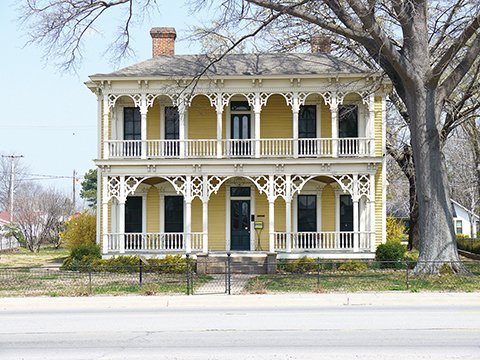SEARCY — It’s hard to miss the majestic, yellow, two-story home that has stood at 300 E. Race St. in downtown Searcy for well over 100 years. The historic home, known to locals as “Black House” in reference to the name of the only family that ever occupied the residence, looks as if it were plucked from the streets of New Orleans. In a way, it was.
The structure started out as a two-room building that was purchased, along with three surrounding lots, by Benjamin Clayton Black in 1866. In March of that year, he married Molly Rosamond Jones, and the couple fell in love with the architectural style of New Orleans while they were honeymooning in that Southern city.
Renovations to the house began in earnest in 1872, with a grand, wooden staircase being imported from France by way of New Orleans, according to a narrative about the home from the Searcy Arts Council. The council has occupied Black House since 1999.
The staircase, which remains a focal point of the house today, was shipped upriver and carefully transported to the Black family home, said Myra Shock, director of the Searcy Arts Council.
When remodeling was complete in 1974, the result was a Victorian style manor that still features intricate woodwork, a large front porch and a second-story veranda. Portions of the flooring and interior walls are believed to be original to the house, while the furnishings have been carefully selected to add to the ambiance of the historic property. The restorations that have helped make Black House a fixture in Searcy’s history have been overseen by the Arkansas Historic Preservation Program to maintain the integrity of the property.
“It is as inviting today as it must have been when Mr. and Mrs. Black and their children enjoyed life here,” Shock said. “There is a feeling of history, walking through this house. Sometimes I like to go out on the porch and imagine what it must have been like to live in that time.”
Benjamin Clayton Black was a Civil War captain. He is said to have surrendered on the block where his home stands in the spring of 1865. He was also a business owner and served his community as White County sheriff and postmaster. His participation in politics led him to the position of mayor of Searcy from 1886 to 1894, as well as chairman of the Democratic Central Committee.
The Blacks are said to have had 11 children, the youngest of which was Lorena Black. She reportedly retired from her career in Washington, D.C., and returned to live in the Black home to care for her mother and sister until their deaths.
After Lorena’s death in 1979, at the age of 101, the house was purchased by the Rodgers family, who later deeded the property to the city of Searcy. Black House was placed on the National Register of Historic Places in 1974.
“Understanding history and where we’ve been is a key for planning our future,” Shock said. “We appreciate the fact that the city offers this to the community.”
She said the Searcy Parks and Recreation Department does a “wonderful job” in maintaining the house and grounds, as do the Master Gardeners, who provide landscaping for the property.
The Searcy Arts Council hosts six major exhibits at its gallery in Black House during the year. Those who want to visit the historic property can do so from 1-4 p.m. Tuesday through Friday. For Saturday hours or information about current exhibits, call (501) 279-1094.
